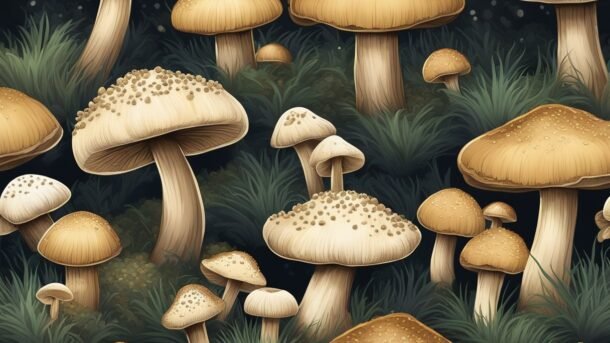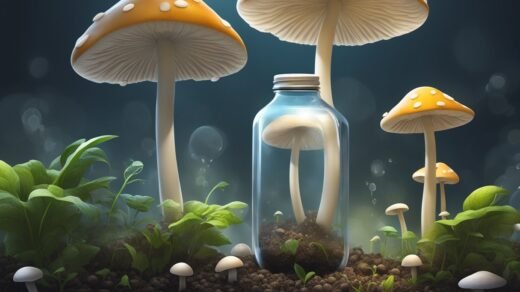Pioppino mushrooms, also known as black poplar mushrooms or velvet pioppino, are a unique and delicious variety of edible mushrooms. They are native to Europe but have gained popularity in the United States and other parts of the world due to their earthy flavor and numerous health benefits. Growing pioppino mushrooms at home is a great way to enjoy their unique taste and reap their nutritional benefits.
To grow pioppino mushrooms, it is important to first understand their growing requirements. These mushrooms prefer high humidity levels and cooler temperatures, specifically ranging from 55 to 65°F (13 to 18°C). They grow best in a substrate made from hardwood sawdust and wheat bran, and require a spawn to inoculate the substrate. With the right growing conditions and proper care, pioppino mushrooms can be easily grown at home and harvested for use in a variety of dishes.
Understanding Pioppino Mushrooms

Species Overview
Pioppino mushrooms (Agrocybe aegerita) are a type of edible mushroom that are native to Europe and Asia. They are also known as the poplar mushroom, black poplar mushroom, or velvet pioppino. The mushrooms have a light brown cap and a white or cream-colored stem. They grow in clusters on decaying hardwood trees, especially poplars.
Pioppino mushrooms are a popular ingredient in Italian and Japanese cuisine. They have a unique flavor and firm texture that make them a great addition to soups, stews, and stir-fries. They are also used in traditional medicine to treat various health conditions.
Nutritional Benefits
Pioppino mushrooms are a good source of vitamins and minerals. They are low in calories and fat, making them a healthy addition to any diet. Here are some of the nutritional benefits of pioppino mushrooms:
- Protein: Pioppino mushrooms are a good source of protein, with about 3 grams per 100 grams of mushrooms.
- Vitamins: Pioppino mushrooms are rich in vitamins B1, B2, and B3. These vitamins are important for maintaining healthy skin, eyes, and nervous system.
- Minerals: Pioppino mushrooms are a good source of potassium, phosphorus, and copper. These minerals are important for maintaining healthy bones, muscles, and blood vessels.
To get the most out of pioppino mushrooms, it is best to cook them before eating. This will help to release their nutrients and improve their digestibility. Whether you are sautéing, grilling, or roasting, pioppino mushrooms are a delicious and nutritious addition to any meal.
Cultivation Requirements

Growing pioppino mushrooms requires proper substrate preparation, temperature, and humidity control. Below are some tips for cultivating pioppino mushrooms successfully.
Substrate Preparation
Pioppino mushrooms grow well on hardwood sawdust supplemented with wheat bran, soybean meal, or other nitrogen-rich supplements. The substrate should be sterilized before use to eliminate any contaminants that may harm the mushrooms.
To prepare the substrate, mix hardwood sawdust with water and nitrogen-rich supplements in a ratio of 5:3:1. After mixing, fill the substrate into bags, jars, or trays, and sterilize using a pressure cooker or steam sterilizer for about 90 minutes. Allow the substrate to cool before inoculation.
Temperature and Humidity Control
Pioppino mushrooms require a temperature range of 55-65°F (13-18°C) and high humidity levels of over 90% to fruit. The fruiting period usually lasts for 2-3 months, depending on the temperature and humidity conditions.
To maintain the required temperature and humidity levels, place the inoculated substrate in a dark, cool, and humid environment. Use a humidifier or misting system to maintain high humidity levels, and a thermometer to monitor the temperature.
In conclusion, cultivating pioppino mushrooms requires proper substrate preparation, temperature, and humidity control. With the right conditions, you can grow delicious and nutritious pioppino mushrooms at home.
Growing Process
Pioppino mushrooms, also known as Agrocybe aegerita, are a delicious and nutritious variety of mushroom that can be easily grown at home. Here is a brief guide on how to grow pioppino mushrooms.
Inoculation
The first step in growing pioppino mushrooms is to inoculate a substrate with mushroom spawn. The substrate can be made from hardwood sawdust, straw, or a combination of both. The mushroom spawn can be purchased from a reputable supplier or obtained from a previous batch of pioppino mushrooms.
Once the substrate has been prepared, the mushroom spawn is mixed in and then packed into bags or containers. The bags or containers are then sealed and left to incubate.
Incubation
During the incubation phase, the bags or containers are kept in a warm, dark, and humid environment. The temperature should be around 75-80°F, and the humidity should be around 90%. The mushroom mycelium will grow and spread throughout the substrate during this phase.
Fruiting
After the mycelium has fully colonized the substrate, the bags or containers are opened and exposed to fresh air and light. The temperature should be lowered to around 60-65°F, and the humidity should be around 70-80%. The pioppino mushrooms will then begin to form and grow.
It is important to keep the growing environment clean and free of contaminants during the fruiting phase. The mushrooms should be harvested when they are fully mature but before the caps start to flatten out.
By following these simple steps, anyone can grow their own delicious pioppino mushrooms at home.
Harvesting and Storage
Harvesting Techniques
Harvesting pioppino mushrooms is a delicate process that requires care and attention to detail. The best time to harvest pioppino mushrooms is when they reach full maturity, which is usually around 5-7 days after the first fruiting. To harvest the mushrooms, gently twist and pull them from the substrate, being careful not to damage the surrounding mycelium.
It is important to harvest pioppino mushrooms at the right time to ensure optimal flavor and texture. Overripe mushrooms can become tough and woody, while underripe mushrooms may not have fully developed their flavor.
Post-Harvest Handling
After harvesting, it is essential to handle pioppino mushrooms with care to ensure their quality and freshness. First, remove any debris or excess substrate from the mushrooms. Then, place them in a clean, dry container lined with paper towels to absorb any excess moisture.
Pioppino mushrooms should be stored in a cool, dark place, such as a refrigerator, to extend their shelf life. Avoid storing them in plastic bags, as this can trap moisture and cause them to spoil more quickly.
When properly stored, pioppino mushrooms can last up to a week or more. To ensure their freshness, inspect them regularly for any signs of spoilage, such as discoloration or a foul odor.
Overall, proper harvesting and storage techniques are essential for maintaining the quality and flavor of pioppino mushrooms. With the right care and attention, you can enjoy these delicious mushrooms for days to come.
Troubleshooting Common Issues
Contamination Prevention
Contamination is a common issue when growing pioppino mushrooms. To prevent contamination, growers should ensure that all equipment is clean and sterilized. It is recommended to use 70% isopropyl alcohol to sterilize all equipment, including work surfaces, containers, and tools. Growers should also wear gloves and a face mask to prevent contamination from their own body.
In addition, it is important to use high-quality spawn and substrate. The spawn should be free from contamination, and the substrate should be pasteurized to kill any potential contaminants. Growers should also ensure that the growing environment is clean and free from contaminants.
Pest Management
Pests can also be a problem when growing pioppino mushrooms. Common pests include mites, flies, and beetles. To prevent pests, growers should keep the growing environment clean and free from debris. They should also use a high-quality substrate that is free from pests.
If pests do become a problem, growers can use natural pest control methods, such as neem oil or insecticidal soap. They can also use sticky traps to catch flying pests.
Overall, by taking the proper precautions and using high-quality materials, growers can prevent common issues when growing pioppino mushrooms.




